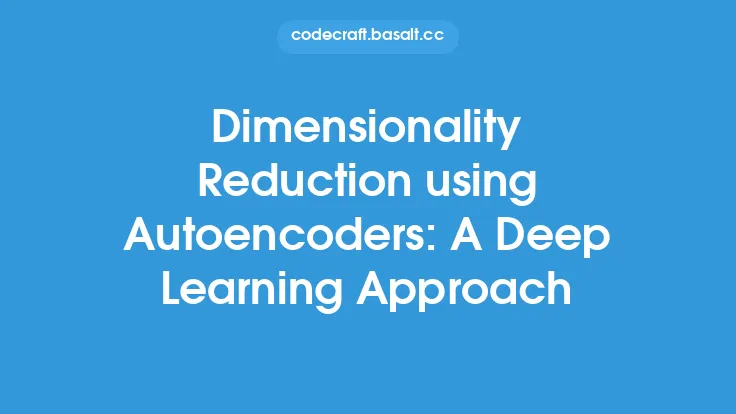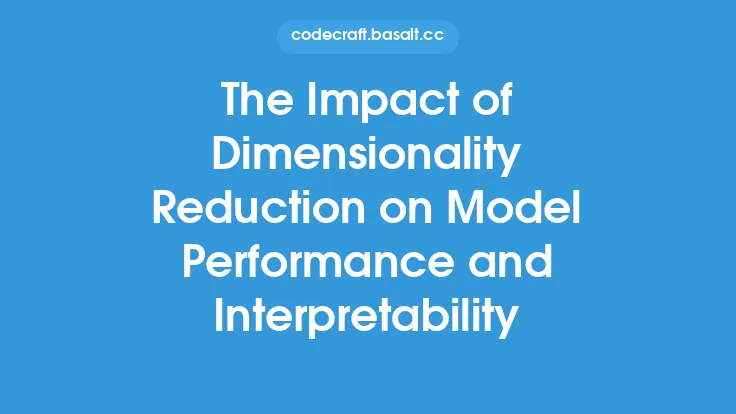Data integrity is a critical aspect of machine learning, as it directly affects the performance and reliability of models. One of the key challenges in maintaining data integrity is dealing with high-dimensional data, which can lead to the curse of dimensionality, noise, and irrelevant features. Dimensionality reduction techniques have emerged as a solution to this problem, enabling the preservation of data integrity by reducing the number of features or dimensions in a dataset while retaining the most important information. In this article, we will delve into the concept of dimensionality reduction and its role in preserving data integrity, exploring the various techniques and their applications.
Introduction to Dimensionality Reduction
Dimensionality reduction is a process of transforming high-dimensional data into a lower-dimensional representation, aiming to preserve the most important features and patterns in the data. This technique is essential in machine learning, as high-dimensional data can lead to overfitting, increased computational complexity, and decreased model interpretability. By reducing the dimensionality of the data, we can improve model performance, reduce noise and irrelevant features, and enhance data visualization. Dimensionality reduction techniques can be broadly categorized into feature selection and feature extraction methods. Feature selection involves selecting a subset of the most relevant features, while feature extraction involves transforming the original features into a new set of features.
Feature Selection Techniques
Feature selection is a widely used dimensionality reduction technique, which involves selecting a subset of the most relevant features from the original dataset. The goal of feature selection is to identify the features that contribute the most to the model's performance and discard the irrelevant or redundant features. There are several feature selection techniques, including filter methods, wrapper methods, and embedded methods. Filter methods evaluate the relevance of features based on statistical measures, such as correlation and mutual information. Wrapper methods use a machine learning algorithm to evaluate the performance of different feature subsets. Embedded methods integrate feature selection into the training process of a machine learning algorithm. Some popular feature selection techniques include recursive feature elimination, LASSO regression, and random forest feature importance.
Feature Extraction Techniques
Feature extraction is another dimensionality reduction technique, which involves transforming the original features into a new set of features. The goal of feature extraction is to create a new representation of the data that is more informative and relevant for the model. There are several feature extraction techniques, including principal component analysis (PCA), singular value decomposition (SVD), and independent component analysis (ICA). PCA is a widely used technique that transforms the data into a new set of orthogonal features, called principal components, which capture the most variance in the data. SVD is a factorization technique that decomposes the data into three matrices, capturing the most important features and patterns. ICA is a technique that separates the data into independent components, which are more informative and relevant for the model.
Linear and Non-Linear Dimensionality Reduction
Dimensionality reduction techniques can be categorized into linear and non-linear methods. Linear methods, such as PCA and SVD, assume a linear relationship between the features and aim to find a linear transformation that captures the most important features. Non-linear methods, such as t-SNE and autoencoders, assume a non-linear relationship between the features and aim to find a non-linear transformation that captures the most important features. Linear methods are faster and more efficient but may not capture complex relationships between the features. Non-linear methods are more flexible and can capture complex relationships but may be computationally expensive and prone to overfitting.
Evaluating Dimensionality Reduction Techniques
Evaluating the performance of dimensionality reduction techniques is crucial to ensure that the reduced data retains the most important information. There are several evaluation metrics, including reconstruction error, classification accuracy, and clustering quality. Reconstruction error measures the difference between the original data and the reconstructed data. Classification accuracy measures the performance of a classifier on the reduced data. Clustering quality measures the quality of clusters in the reduced data. It is essential to choose the right evaluation metric based on the specific problem and dataset.
Preserving Data Integrity
Dimensionality reduction techniques play a critical role in preserving data integrity by reducing the number of features or dimensions in a dataset while retaining the most important information. By removing irrelevant and redundant features, dimensionality reduction techniques can improve model performance, reduce noise, and enhance data visualization. Additionally, dimensionality reduction techniques can help to prevent overfitting, which occurs when a model is too complex and fits the noise in the data. By reducing the dimensionality of the data, we can create a more robust and generalizable model that performs well on unseen data.
Real-World Applications
Dimensionality reduction techniques have numerous real-world applications, including image compression, text classification, and gene expression analysis. In image compression, dimensionality reduction techniques can reduce the number of pixels in an image while retaining the most important features. In text classification, dimensionality reduction techniques can reduce the number of features in a text document while retaining the most important words and phrases. In gene expression analysis, dimensionality reduction techniques can reduce the number of genes in a dataset while retaining the most important genes and patterns.
Conclusion
In conclusion, dimensionality reduction techniques play a critical role in preserving data integrity by reducing the number of features or dimensions in a dataset while retaining the most important information. By removing irrelevant and redundant features, dimensionality reduction techniques can improve model performance, reduce noise, and enhance data visualization. With numerous real-world applications, dimensionality reduction techniques are an essential tool in machine learning and data analysis. As the complexity and size of datasets continue to grow, dimensionality reduction techniques will become increasingly important in preserving data integrity and improving model performance.





